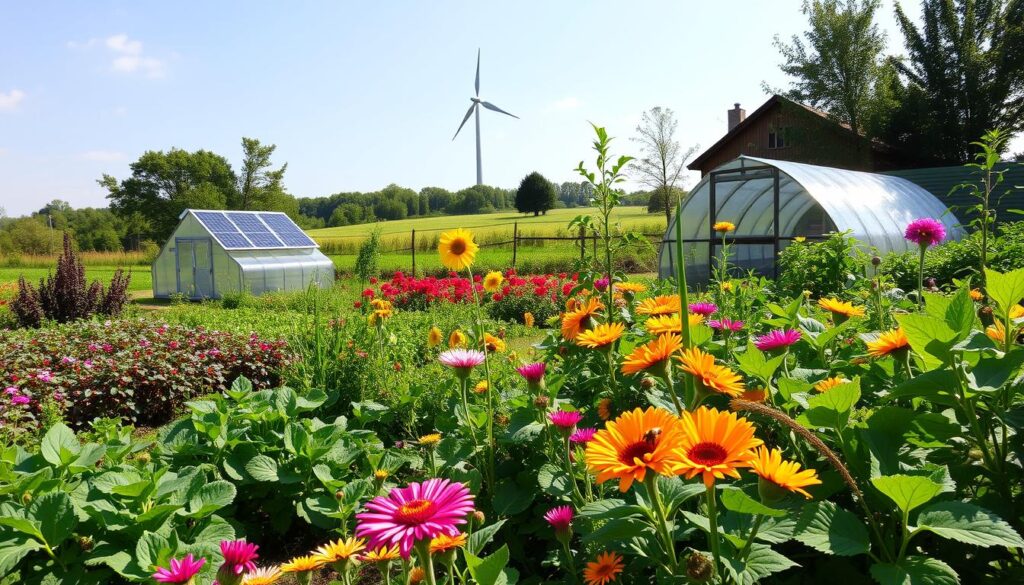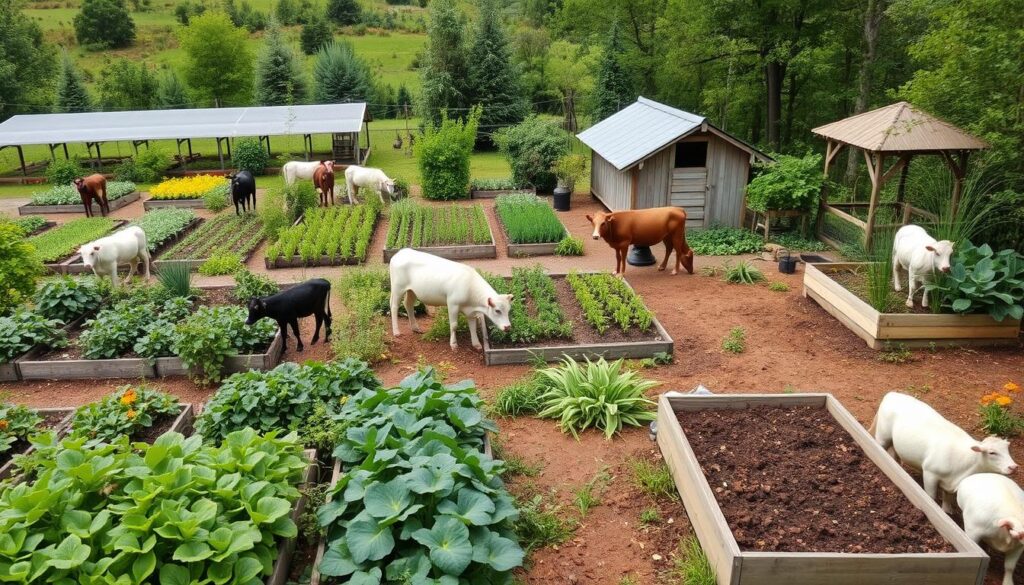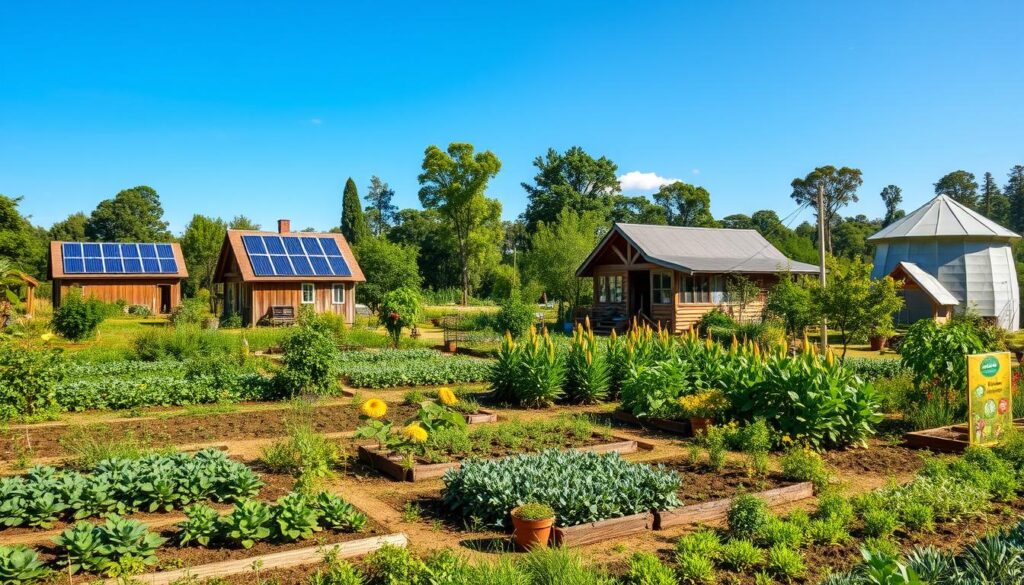What does it take to succeed in permaculture entrepreneurship? How can we use sustainable business practices to grow an eco-friendly startup? With the world’s population growing, we face big problems like ecocide and deforestation. Now, more than ever, we need permaculture entrepreneurship.
Studies show that 80% of results come from just 20% of efforts. So, having a solid plan is key to moving from student to professional.
Permaculture entrepreneurship means running a business that’s good for the planet. It makes money and helps the environment by avoiding harmful chemicals. By knowing what customers want, entrepreneurs can build a loyal following and stay competitive.
As global warming hurts biodiversity and food chains, permaculture offers a solution. It boosts local food production and cuts down on global supply chain reliance.
Key Takeaways
- Permaculture entrepreneurship requires a strategic framework to succeed
- Sustainable business practices are essential for creating a thriving eco-friendly startup
- Understanding customer needs and designing business models according to them is crucial for success
- Permaculture entrepreneurship can help increase food security by promoting local food production
- Reducing reliance on chemical fertilizers and pesticides is a key aspect of permaculture entrepreneurship
- Permaculture businesses can benefit from integrating multiple crops and utilizing market trends effectively
Understanding Permaculture Principles
Permaculture is a way to live sustainably. It focuses on designing systems that work well together. This is key for regenerative agriculture businesses to reduce their environmental impact.
In green entrepreneurship, permaculture offers a way to make money while being sustainable. It helps businesses use less non-renewable resources and waste less. This fits well with sustainable entrepreneurship, which looks at long-term success.
History and Evolution of Permaculture
Permaculture started in the 1970s with Bill Mollison and David Holmgren. They created it to tackle environmental issues. Now, it covers many areas like agriculture, ecology, and social justice.
Core Ethics of Permaculture
The core of permaculture is Earth Care, People Care, and Fair Share. These values are crucial for a sustainable business. They help ensure the well-being of people and the planet, making businesses more viable in the long run.
Designing Sustainable Systems
Designing sustainable systems is central to permaculture. It aims to create efficient systems with minimal waste. By using permaculture, businesses can build more resilient and diverse systems. These systems are better prepared for a changing world.
The Foundation of Permaculture Entrepreneurship
Defining your mission and vision is key in permaculture entrepreneurship. It helps you find your target market and niche. Jason Thomas says this step is vital for a successful permaculture business. By focusing on sustainable entrepreneurship, you can start ethical business ventures that positively impact society.
Permaculture entrepreneurship is more than just making money. It’s about building sustainable businesses that help people and the planet. By caring for the environment and community, you can create social impact businesses that last.
Defining Your Mission and Vision
To define your mission and vision, think about what drives you. What do you want to achieve with your permaculture business? This means identifying your values, goals, and who you want to serve. By doing this, you can create a unique value proposition that makes your business stand out.

Identifying Target Market and Niche
Finding your target market and niche is crucial for success. You need to research your competition and understand your market’s needs. Then, create products or services that meet those needs. By focusing on a specific niche, you can make your business unique and build a strong reputation.
Developing a Sustainable Business Model
Creating a sustainable business model is key for eco-friendly startups and permaculture businesses. It involves looking closely at how money comes in and goes out. Also, planning finances is important to make sure the business can keep going.
Using sustainable practices is vital for lasting success. Companies that focus on the triple bottom line can grow in value over time. This doesn’t mean they have to sacrifice making money.
Some important steps for a sustainable business model include:
- Using circular economy ideas to use fewer resources
- Producing with less energy to waste less
- Choosing renewable resources for a greener future
- Working with others to innovate and grow
These steps help businesses lessen their environmental footprint while staying financially strong. For instance, adopting lean methods can boost efficiency by up to 30%. Switching to energy-saving buildings can cut energy use by 20-50%.
Permaculture business can help the environment by improving soil, saving water, and cutting down on chemicals. Eco-friendly startups can make a difference while earning money and creating jobs.
| Strategy | Benefits |
|---|---|
| Implementing circular economy principles | Less resource use, better financial health |
| Emphasizing energy-efficient production | Less energy waste, better for the planet |
| Utilizing renewable resources | Helps move to a greener economy, less dependence on limited resources |
Marketing Your Permaculture Business
Marketing a permaculture business needs a special touch. It’s all about green entrepreneurship and regenerative agriculture businesses. A strong brand helps share your mission and values with others.
Using digital tools like social media and email is key. It helps you reach more people. Also, being active in your community is important. It lets you meet others who care about the same things. 
Here are some marketing tips for permaculture businesses:
- Make your message clear and easy to understand.
- Have a strong online presence with social media and a website.
- Build connections with people and partners through community work and networking.
By using these strategies, you can market your permaculture business well. This helps spread the word about sustainable entrepreneurship.
Key Skills for Permaculture Entrepreneurs
Permaculture entrepreneurs need many skills to do well. They must know about plants and business, and how to work with others. These skills help them start and grow eco-friendly businesses.
Some important skills include:
- Horticultural knowledge and practices, such as soil fertility management and water conservation
- Business management essentials, such as financial planning and marketing strategies
- Networking and collaboration, such as building relationships with suppliers and partners
With these skills and a love for permaculture, people can build thriving businesses. These businesses help the environment and support a green community.
As permaculture business grows, it’s key for entrepreneurs to keep learning. They should follow the latest in sustainable business and eco-friendly startups. This way, they can make their businesses last and help create a better future.
Building a Permaculture-Based Product Line
Building a product line based on permaculture means focusing on local sourcing. This method cuts down on carbon emissions and boosts the local economy. It helps businesses create a line that’s both green and profitable.
Key to this is sustainable entrepreneurship. It’s about making products that meet today’s needs without harming tomorrow’s. This way, businesses can positively impact the environment and the community. For instance, using local materials reduces transportation needs and supports local farmers.

- Picking products that match permaculture and regenerative agriculture businesses values
- Choosing local materials to lower carbon footprint and help the local economy
- Creating products that serve today’s needs without hurting tomorrow’s
By taking these steps, businesses can make a sustainable and profitable line. This supports the local economy and environment. It’s crucial for sustainable entrepreneurship and helps businesses succeed over time.
Project Planning and Management
Effective project planning and management are key for sustainable entrepreneurship and ethical business ventures. Setting realistic goals and milestones is crucial. Using permaculture design principles helps businesses create a positive social impact. It also makes sure their operations are good for the environment and profitable.
Research and analysis are important in project planning. Businesses need to look at market demand, resource availability, and potential challenges. This helps them develop strategies that reduce risks and increase growth chances. For example, social impact businesses can create products or services that solve social or environmental issues while making money.
- Regenerative measures have led to more water infiltration and aquifer recharge.
- Effective natural resource management can decrease erosion rates.
- The American bison once roamed in large numbers, helping to create thick topsoil.
| Strategy | Benefits |
|---|---|
| Regenerative measures | Increased water infiltration, reduced erosion |
| Natural resource management | Improved soil health, increased biodiversity |
| Permaculture design | Enhanced ecosystem services, increased resilience |
By taking a holistic approach to project planning and management, businesses can positively impact the environment and society. They can also ensure their long-term success and sustainability.
Financial Support and Funding Options
For eco-friendly startups and permaculture entrepreneurship, getting financial support is key. Sustainable business practices need money, and there are many ways to get it. The California Department of Food and Agriculture (CDFA) has programs like the Alternative Manure Management Program (AMMP) and the Healthy Soils Program (HSP). These help with funding for green farming.
Some important funding options include:
- Grants for sustainable businesses, such as the Conservation Agriculture Planning Grant Program
- Crowdfunding strategies, which can help permaculture entrepreneurship and eco-friendly startups
- Programs like the Dairy Digester Research and Development Program (DDRDP) and the State Water Efficiency and Enhancement Program (SWEEP)
These programs show how vital financial support is for green businesses. By looking into these options, permaculture entrepreneurs can get the money they need to start and grow their eco-friendly startups.

| Program | Description |
|---|---|
| AMMP | Alternative Manure Management Program, focusing on non-digester practices |
| HSP | Healthy Soils Program, encompassing several components, including incentives and demonstration projects |
| DDRDP | Dairy Digester Research and Development Program, providing financial assistance for dairy digesters |
Case Studies of Successful Permaculture Ventures
Green entrepreneurship and regenerative agriculture are booming. Many permaculture ventures are leading the way in sustainable business. La Ferme du Bec Hellouin in France is a great example. This farm grows a wide variety of produce on just 0.9 acres. They supply up to 100 vegetable boxes a week to locals and fancy restaurants.
This farming method is not just sustainable, but also super productive. Permaculture farms can grow up to ten times more than traditional organic farms. This shows how green entrepreneurship and regenerative agriculture can make our food system better.
Community Supported Agriculture (CSA)
Community Supported Agriculture (CSA) programs are another success story. They let people buy shares in a farm’s produce regularly. This supports local, sustainable farming and connects farmers directly with consumers.
Eco-Tourism and Educational Workshops
Eco-tourism and workshops are key parts of many permaculture projects. They let people learn about sustainable living and see permaculture in action. These ventures help make business more eco-friendly and socially responsible.
| Permaculture Venture | Location | Description |
|---|---|---|
| La Ferme du Bec Hellouin | France | Produces a variety of produce on 0.9 acres, supplying local customers and restaurants |
| Permaculture Literacy Program | Philippines | Empowers young people to implement sustainable farming practices in their communities |
Regulations and Certifications
Starting a permaculture business means dealing with rules and getting certifications. Eco-friendly startups need permits and labels to stay legal and keep their good name.
In the United States, permaculture experts can earn about $300 a day. This rate can change based on where you are, offering more chances to make money in some places.
Some important certifications and rules for permaculture businesses are:
- Organic certification
- Local labels
- Necessary permits for permaculture projects
By following these rules and getting the right certifications, permaculture entrepreneurs can build thriving, green businesses. These businesses help the environment and support a healthier world.
| Certification | Description |
|---|---|
| Organic certification | Ensures that products meet organic standards |
| Local labels | Indicates that products are produced locally |
| Necessary permits | Required for permaculture projects to operate legally |
Utilization of Technology in Permaculture
Technology is key in permaculture, helping farms run smoothly. It lets entrepreneurs manage their land better. This leads to less waste and more green business growth.
Tools like software track crops and soil health. They also manage water use. This makes farming smarter and greener. Online platforms help sell products, reaching those who want sustainable choices.
Technology helps permaculture farms work better and greener. It boosts business and supports a sustainable economy. As people want more green products, tech-savvy farms will lead the way.
Challenges Facing Permaculture Entrepreneurs
Permaculture entrepreneurs deal with many challenges. These include environmental and climate issues, and competition in the market. These hurdles can make it tough for sustainable entrepreneurship to succeed. They aim to make social impact businesses that care for the environment and society.
Entrepreneurs in permaculture often lack hands-on design skills. They also face negative views from the public and limited funds. Plus, not working with schools can make it hard for ethical business ventures to be accepted.
To beat these obstacles, entrepreneurs need to develop a strong business mindset. They should build a professional network and find a clear niche. This way, they can run a successful sustainable entrepreneurship venture. It will have a positive social impact and help the environment.
By tackling these challenges and planning well, permaculture entrepreneurs can succeed. They can make a big difference in the social impact businesses world.
Resource Management in Permaculture
Effective resource management is key for eco-friendly startups and permaculture entrepreneurship. It includes managing soil, water, and energy to build a sustainable business. This way, permaculture entrepreneurs can lower their environmental impact and boost their profits.
Some important strategies for managing resources in permaculture are:
- Using renewable energy like solar power to cut down on fossil fuels
- Conserving water with efficient systems and rainwater harvesting
- Boosting soil health with organic amendments and crop rotation
By focusing on resource management, permaculture entrepreneurs can build a sustainable and strong business. This approach not only helps the environment but also supports the business’s long-term success. As more people look for eco-friendly products and services, permaculture entrepreneurship is becoming a vital part of the sustainable business world.
Innovations in Permaculture Entrepreneurship
Permaculture entrepreneurship is changing fast. New trends in sustainable living and food systems are emerging. Green entrepreneurship is leading this change, focusing on eco-friendly and socially responsible business.
Regenerative agriculture businesses are also growing. They focus on soil health, biodiversity, and capturing carbon.
Some key innovations in permaculture entrepreneurship include:
- Integrated food systems, such as community-supported agriculture (CSA) and aquaponics
- Circular economy approaches, such as zero-waste clothing design and modular, repairable products
- Digital platforms for marketing and sales, which are being used by approximately 70% of permaculture entrepreneurs
Sustainable entrepreneurship is key now. People want products and services that are good for the planet and society. Businesses that go green can cut their environmental harm, boost their image, and keep customers coming back. In fact, they might see a 15-20% jump in customer loyalty.
As more people look for sustainable options, permaculture entrepreneurship is set to be big in food systems. It combines regenerative agriculture, green business, and sustainability. This field is full of innovation and promise.
| Innovation | Description |
|---|---|
| Integrated food systems | Community-supported agriculture (CSA), aquaponics, and other local food systems |
| Circular economy approaches | Zero-waste clothing design, modular, repairable products, and other sustainable practices |
| Digital platforms | Online marketing and sales platforms, used by approximately 70% of permaculture entrepreneurs |
The Role of Education and Outreach
The permaculture movement is growing fast. Permaculture entrepreneurs need to teach their communities. They do this through workshops and hands-on learning.
This helps people understand permaculture better. It also encourages them to live more eco-friendly lives.
In the UK, jobs in sustainable agriculture are expected to grow by 15% in the next decade. This shows how crucial it is to have skilled workers in permaculture. The UK’s agriculture sector also adds £24 billion to the economy each year.
This means permaculture businesses can do well. By teaching and empowering local communities, entrepreneurs can help the environment and boost the economy.

